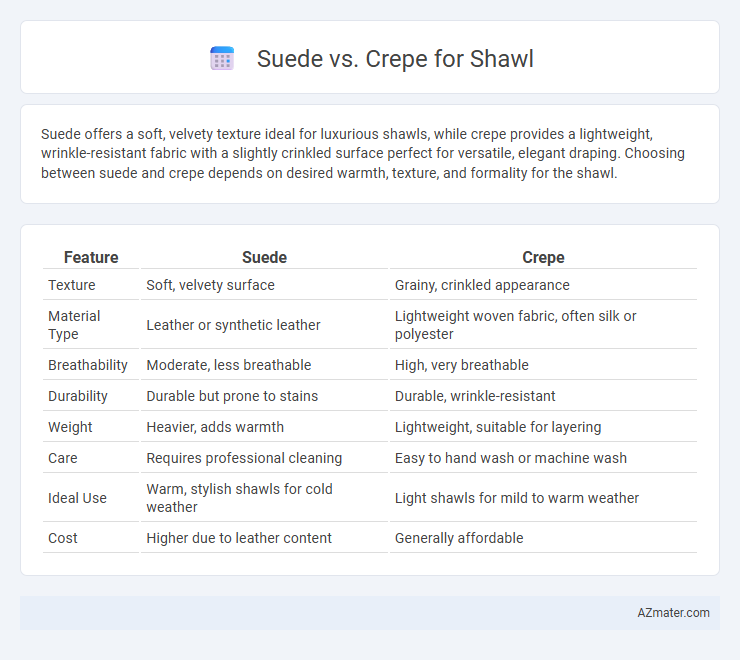Suede offers a soft, velvety texture ideal for luxurious shawls, while crepe provides a lightweight, wrinkle-resistant fabric with a slightly crinkled surface perfect for versatile, elegant draping. Choosing between suede and crepe depends on desired warmth, texture, and formality for the shawl.
Table of Comparison
| Feature | Suede | Crepe |
|---|---|---|
| Texture | Soft, velvety surface | Grainy, crinkled appearance |
| Material Type | Leather or synthetic leather | Lightweight woven fabric, often silk or polyester |
| Breathability | Moderate, less breathable | High, very breathable |
| Durability | Durable but prone to stains | Durable, wrinkle-resistant |
| Weight | Heavier, adds warmth | Lightweight, suitable for layering |
| Care | Requires professional cleaning | Easy to hand wash or machine wash |
| Ideal Use | Warm, stylish shawls for cold weather | Light shawls for mild to warm weather |
| Cost | Higher due to leather content | Generally affordable |
Introduction to Shawl Fabrics
Suede and crepe are popular fabric choices for shawls, each offering unique textures and properties. Suede provides a soft, velvety surface with a subtle sheen, ideal for warmth and a luxurious feel, while crepe features a lightweight, crinkled texture that drapes elegantly and enhances breathability. Selecting between suede and crepe depends on desired comfort, style, and the specific occasion where the shawl will be worn.
What is Suede?
Suede is a type of leather made from the underside of animal hide, primarily lamb or goat, characterized by its soft, napped finish that offers a velvety texture ideal for shawls. Its durability and breathable nature make it a popular choice for luxurious, warm shawls suitable for cooler climates. Unlike crepe, which is a fabric with a crinkled texture, suede provides a rich, tactile feel and a distinctive visual depth that enhances shawl aesthetics.
What is Crepe?
Crepe is a lightweight fabric characterized by a crinkled or pebbled texture, often made from silk, wool, or synthetic fibers, providing a soft drape ideal for shawls. Unlike suede, which is heavier and has a smooth, velvety surface, crepe offers breathability and flexibility, enhancing comfort during wear. Its distinctive texture adds a subtle visual interest, making crepe shawls versatile for both formal and casual occasions.
Texture and Feel: Suede vs Crepe
Suede offers a soft, velvety texture with a luxurious, slightly fuzzy surface that feels warm and plush against the skin. Crepe fabric provides a distinctive crinkled or pebbled texture that is lightweight, breathable, and drapes gracefully, creating an elegant and fluid feel. The choice between suede's rich softness and crepe's textured lightness depends on whether warmth or breathability is prioritized for the shawl.
Breathability and Comfort Comparison
Suede shawls offer a soft, velvety texture but tend to have lower breathability, making them warmer and less ideal for extended wear in warm climates. Crepe shawls, crafted from lightweight, tightly twisted fibers, provide superior breathability and moisture-wicking properties, enhancing comfort during prolonged use. The choice between suede and crepe ultimately hinges on the desired balance between warmth and ventilation in shawl material.
Durability: Which Lasts Longer?
Suede shawls offer moderate durability but are prone to staining and wear over time, especially in humid conditions. Crepe shawls, crafted from tightly woven fibers, generally last longer due to their resistance to tearing and wrinkling. Choosing crepe guarantees extended longevity and better maintenance for everyday use.
Style and Drape Differences
Suede shawls offer a smooth, velvety texture that provides a structured, polished look suitable for formal or upscale occasions. Crepe shawls feature a lightweight, crinkled surface that allows for a soft, flowing drape, enhancing movement and a more relaxed, elegant style. The choice between suede and crepe impacts the shawl's silhouette significantly, with suede maintaining shape while crepe adapts fluidly to the wearer's movements.
Maintenance and Cleaning Tips
Suede shawls require careful maintenance, including gentle brushing with a suede brush to remove dirt and spot cleaning with specialized suede cleaners to prevent damage. Crepe shawls are easier to maintain, typically needing gentle hand washing in cold water with mild detergent and air drying to preserve fabric texture. Storing both shawls in breathable garment bags helps avoid moisture and mildew, extending their lifespan.
Best Occasions for Each Fabric
Suede shawls are ideal for formal events and evening wear due to their luxurious texture and elegant appearance, providing warmth and sophistication in cooler weather. Crepe shawls, known for their lightweight and breathable qualities, are perfect for daytime occasions, casual outings, and spring or summer events where comfort and style need to balance. Selecting between suede and crepe depends largely on the event's formality, season, and desired aesthetic, with suede suiting upscale environments and crepe fitting more relaxed settings.
Conclusion: Choosing the Right Shawl Fabric
Suede offers a luxurious, soft texture with excellent durability, making it ideal for elegant shawls used in cooler weather. Crepe provides a lightweight, breathable fabric with a graceful drape, perfect for versatile and comfortable shawls in warmer climates. Selecting the right shawl fabric depends on balancing style, comfort, and seasonality, with suede suited for structured sophistication and crepe excelling in fluidity and ease of wear.

Infographic: Suede vs Crepe for Shawl
 azmater.com
azmater.com